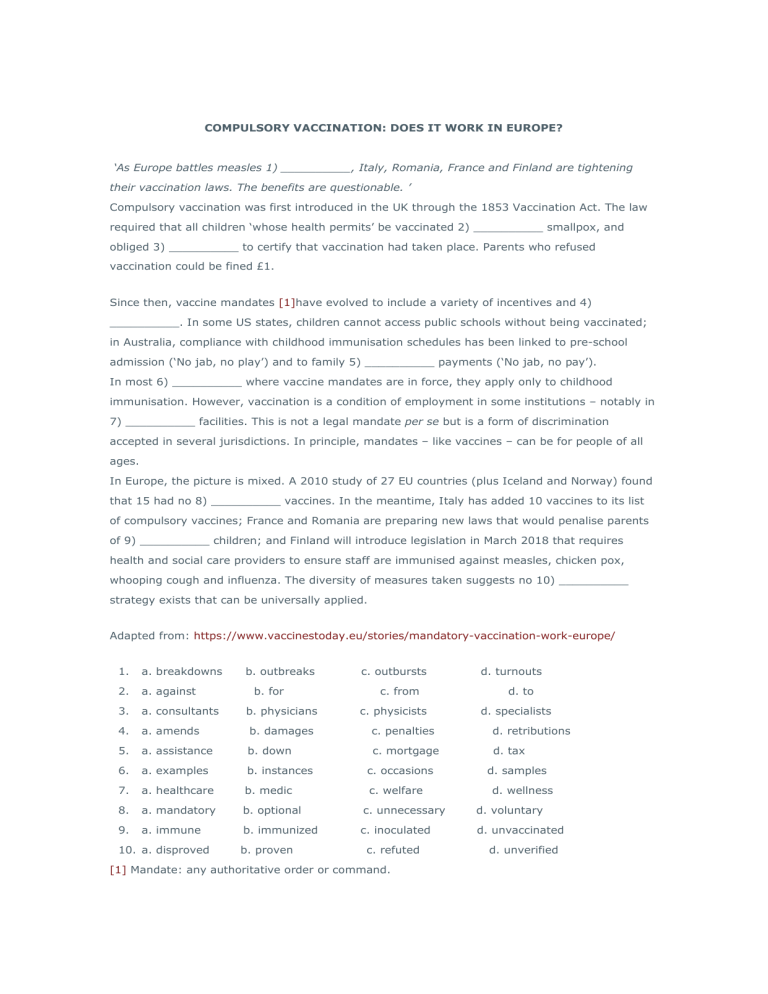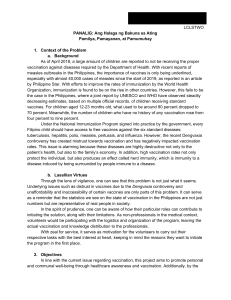
COMPULSORY VACCINATION: DOES IT WORK IN EUROPE? ‘As Europe battles measles 1) __________, Italy, Romania, France and Finland are tightening their vaccination laws. The benefits are questionable. ’ Compulsory vaccination was first introduced in the UK through the 1853 Vaccination Act. The law required that all children ‘whose health permits’ be vaccinated 2) __________ smallpox, and obliged 3) __________ to certify that vaccination had taken place. Parents who refused vaccination could be fined £1. Since then, vaccine mandates [1]have evolved to include a variety of incentives and 4) __________. In some US states, children cannot access public schools without being vaccinated; in Australia, compliance with childhood immunisation schedules has been linked to pre-school admission (‘No jab, no play’) and to family 5) __________ payments (‘No jab, no pay’). In most 6) __________ where vaccine mandates are in force, they apply only to childhood immunisation. However, vaccination is a condition of employment in some institutions – notably in 7) __________ facilities. This is not a legal mandate per se but is a form of discrimination accepted in several jurisdictions. In principle, mandates – like vaccines – can be for people of all ages. In Europe, the picture is mixed. A 2010 study of 27 EU countries (plus Iceland and Norway) found that 15 had no 8) __________ vaccines. In the meantime, Italy has added 10 vaccines to its list of compulsory vaccines; France and Romania are preparing new laws that would penalise parents of 9) __________ children; and Finland will introduce legislation in March 2018 that requires health and social care providers to ensure staff are immunised against measles, chicken pox, whooping cough and influenza. The diversity of measures taken suggests no 10) __________ strategy exists that can be universally applied. Adapted from: https://www.vaccinestoday.eu/stories/mandatory-vaccination-work-europe/ 1. a. breakdowns 2. a. against 3. a. consultants 4. a. amends b. damages c. penalties d. retributions 5. a. assistance b. down c. mortgage d. tax 6. a. examples b. instances c. occasions 7. a. healthcare b. medic c. welfare 8. a. mandatory b. optional c. unnecessary d. voluntary 9. a. immune b. immunized c. inoculated d. unvaccinated c. refuted d. unverified 10. a. disproved b. outbreaks b. for b. physicians b. proven c. outbursts c. from c. physicists [1] Mandate: any authoritative order or command. d. turnouts d. to d. specialists d. samples d. wellness KEY 1. B. OUTBREAKS 2. A. AGAINST 3. B. PHYSICIANS 4. C. PENALTIES 5. B. DOWN 6. B. INSTANCES 7. A. HEALTHCARE 8. A. MANDATORY 9. D. UNVACCINATED 10. B. PROVEN SLOW ART? IT WILL ‘BLOW YOUR MIND’ First there was slow food, then slow journalism and now it’s the turn of slow art… It’s all part of Slow Art Day, an annual global event with some 200 institutions signed up, 0) __________ Tate Modern, Ashmolean Museum, Photographer’s Gallery, Ulster Museum and Yorkshire Sculpture Park. “Many people don’t know how to look at and love art and are disconnected 1) __________ it,” explains Phil Terry, the founder of Slow Art Day. “Visitors to galleries often see art from their iPads or mobile phones and slow art is an antidote to that. “By slowing down, it helps us to see art in a new way that energises 2) __________ than demoralises, it will blow your mind!” 3) __________ record numbers of people are going to galleries, visitors only spend around 15 to 30 seconds looking at a piece of art, which is 4) __________ time than we tend to spend looking at a page on the internet, according to art critic and founder of The Slow Art Workshop Susan Moore. She believes it’s very hard for people in the modern world “to concentrate” and people often “rush around” looking at hundreds of artworks but might 5) __________ see none of them. “There’s this unspoken museum etiquette,” she says, “where everybody stands in a reverential arc about six feet away from a painting but 6) __________ looks at it properly and I think you need the time and space to see one or two paintings and to really look and shut out all the noise.” One gallery trying to shut out the noise is Tate Modern, which is offering slow art sessions to help visitors get the 7) __________ out of its art including its current Pierre Bonnard exhibition. “The more you look the more you see,” points out curator Matthew Gale, who believes the best way of looking at an artwork is to follow where the artist takes you and by looking 8) __________ the picture frame. “If you give them the time, you will see things that are secret, that can intrigue and raise questions about 9) __________ the painting was made and what the artist was thinking. To get people in the mood for slow art, Christie’s, the V&A and the Natural History Museum have been offering yoga and sound meditation baths 10) __________ visitors step foot into their exhibitions. It’s all about switching on their senses. “When the Natural History Museum was built and founded it was called a cathedral to nature and people used to come in and take their hats 11) __________ in awe,” says Lucy Woodbridge, head of events at the Natural History Museum, who likens slow art to sacred looking. “And this is what we want: a place of learning and stopping and a deeper level of engagement and just allowing people to see more.” So how 12) __________ should we be looking at a piece of art and at what point does it become ineffective? https://www.bbc.com/news/entertainment-arts-47699001 FEARS AND PHOBIAS It is human nature to avoid emotions that 0) __________ us. Who wants to walk directly into what promises to be a 1) __________ experience? Except that by continually avoiding looking at the ‘boogeyman’ within, you become 2) __________ to the monster. Typically this involves hiding from any potential stressor that might cause upset and engaging in 3) __________ distractions. Unfortunately, you are also hiding from potential challenges that can lead to 4) __________ and joy. What’s more, you can’t hide forever from fear. It’s going to strike 5) __________ your best efforts to suppress it. And it is likely that it will strike at a time when you most need emotional equanimity. The good news is that once you face your fear—and give the boogeyman air— 6) __________ than shove it into a distant compartment of your brain, it begins losing the ability to 7) __________ you and dictate your decisions. Earlier this year the journal Science published a study 8) __________ by researchers from the École Polytechnique Fédérale de Lausanne (EPFL) using mice that showed how the brain actually has to re-experience a fear in order to extinguish it. The rodents were initially put into a small box and given a 9) __________ shock. Over a long period, the researchers returned the mice to the box but didn’t administer shocks. Initially, the mice froze but with repeated exposure to the box, and no additional shocks, they eventually relaxed. For humans repeated exposure to the event(s) that created the trauma can help the anxiety to 10) __________. For example, the treatment for fear of flying is often exposure therapy that involves slowly and repeatedly being exposed to the object that is feared in a controlled environment. CONDUCTED GROWTH MORE RULE DESPITE HOSTAGE PAINFUL RUN DISREGARD INCREASE RATHER SCARE ENDLESS MILD RESEARCHED SUBSIDE KEY 0. SCARE 1. PAINFUL 2. HOSTAGE 3. ENDLESS 4. GROWTH 5. DESPITE 6. RATHER 7. RUN 8. CONDUCTED 9. MILD 10. SUBSIDE



